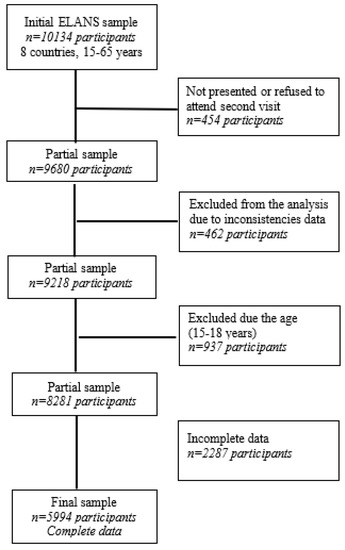Latin American Study of Nutrition and Health (ELANS)
(Closed)
Share This Project Collection
Editors
 Dr. Gerson Ferrari
Dr. Gerson Ferrari
 Dr. Gerson Ferrari
Dr. Gerson Ferrari
E-Mail
Website
Project Leader
Escuela de Ciencias de la Actividad Física, el Deporte y la Salud, Universidad de Santiago de Chile (USACH), Santiago 3363, Chile
Interests: physical activity; sedentary behavior; obesity; healthy lifestyle; exercise science; public health; nutritional epidemiology
Special Issues, Collections and Topics in MDPI journals
 Dr. Mauro Fisberg
Dr. Mauro Fisberg
 Dr. Mauro Fisberg
Dr. Mauro Fisberg
E-Mail
Website
Project Leader
Nutrition and Feeding Difficulties Excellence Center (CENDA) Instituto Pensi, Fundação José Luiz Egydio Setubal, Hospital Infantil Sabará, São Paulo, Brazil; Departamento de Pediatria da Universidade Federal de São Paulo, São Paulo, Brazil
Interests: exercise science; nutrition; infant nutrition; nutrition assessment; nutrition education; feeding behavior; obesity
Special Issues, Collections and Topics in MDPI journals
 Dr. Irina Kovalskys
Dr. Irina Kovalskys
 Dr. Irina Kovalskys
Dr. Irina Kovalskys
E-Mail
Website
Project Leader
Carrera de Nutrición, Facultad de Ciencias Médicas, Pontificia Universidad Católica Argentina, Buenos Aires, Argentina
Interests: nutritional assessment; body composition; nutritional education; clinical nutrition; nutrition; dietetics
Special Issues, Collections and Topics in MDPI journals
Project Overview
Dear Colleagues,
The Latin American Study of Nutrition and Health (ELANS) is a collaboration among scientists from eight countries using a common design and comparable methods across the region. The study uses a large sample (15–65 years) of more than 9000 people in urban areas. Participants were chosen by a randomized complex, multistage sampling and the recruitment was done pairing sex, age, and socioeconomic level. ELANS provided an opportunity to compare estimates of behavior between countries and to investigate the influence of lifestyle characteristics and obesity in a multinational study.
Several ELANS principal investigators, collaborators and students, were stimulated to develop several manuscripts many already published. Papers appearing in this issue—project collection—are the result of these efforts. In addition, each site principal investigator has been encouraged to pursue relevant studies within their own country using regional data. We are proud of the team, their effort and the end results. We hope that the impact on the field of obesity will be felt for many years into the future through the sustained efforts of the research team. The project collection will contribute to efforts to accurately estimate the lifestyle characteristics and to prevent obesity in Latin America region.
Dr. Gerson Ferrari
Dr. Mauro Fisberg
Dr. Irina Kovalskys
Project Leaders
Manuscript Submission Information
Manuscripts should be submitted online at www.mdpi.com by registering and logging in to this website. Once you are registered, click here to go to the submission form. Manuscripts can be submitted until the deadline. All submissions that pass pre-check are peer-reviewed. Accepted papers will be published continuously in the journal (as soon as accepted) and will be listed together on the collection website. Research articles, review articles as well as short communications are invited. For planned papers, a title and short abstract (about 100 words) can be sent to the Editorial Office for announcement on this website.
Submitted manuscripts should not have been published previously, nor be under consideration for publication elsewhere (except conference proceedings papers). All manuscripts are thoroughly refereed through a single-blind peer-review process. A guide for authors and other relevant information for submission of manuscripts is available on the Instructions for Authors page. International Journal of Environmental Research and Public Health is an international peer-reviewed open access monthly journal published by MDPI.
Please visit the Instructions for Authors page before submitting a manuscript.
The Article Processing Charge (APC) for publication in this open access journal is 2500 CHF (Swiss Francs).
Submitted papers should be well formatted and use good English. Authors may use MDPI's
English editing service prior to publication or during author revisions.
Keywords
- nutrition
- obesity
- physical activity
- sedentary behavior
- overweight
- obesity
- lifestyle
- Latin America
Published Papers (3 papers)
Open AccessArticle
Energy Imbalance Gap, Anthropometric Measures, Lifestyle, and Sociodemographic Correlates in Latin American Adults—Results from the ELANS Study
by
Martha Cecilia Yépez García, Marianella Herrera-Cuenca, Gerson Ferrari, Lilia Yadira Cortés Sanabria, Pablo Hernández, Rafaela Yépez Almeida, Mónica Villar Cáceres, Georgina Gómez, Rossina Pareja, Attilio Rigotti, Irina Kovalskys and Mauro Fisberg
Cited by 3 | Viewed by 3894
Abstract
Overweight and obesity are often explained by an imbalance between energy intake and expenditure. This, in addition to metabolic effects, makes it difficult to assess the real state of individual energy balance. This study aims to analyze the energy gaps between intake and
[...] Read more.
Overweight and obesity are often explained by an imbalance between energy intake and expenditure. This, in addition to metabolic effects, makes it difficult to assess the real state of individual energy balance. This study aims to analyze the energy gaps between intake and expenditure in the adult population of Latin America, as well as its relationships with sociodemographic variables and nutrition status, to draw an epidemiological perspective based on the trends observed. The energy imbalance gap was used to this end. The difference between energy intake and expenditure can be applied as a reference to explain whether weight equilibrium can prevent weight gain. Moreover, the energy imbalance gap allows for a better understanding of the design of public health policies. Using data from the Latin American Study of Nutrition and Health, the energy imbalance gap in adult population from eight Latin-American countries was assessed in 5994 subjects aged from 19–65. Usual dietary intake was measured using two non-consecutive 24 h dietary recalls. The sociodemographic questionnaire was supplemented by anthropometric measurements. Physical activity was measured through the long International Physical Activity Questionnaire. Energy expenditure was obtained using the basal metabolic rate. For the overall sample, the mean energy intake was 1939.1 kcal (95% CI: 1926.9; 1951.3), the mean of energy expenditure was 1915.7 kcal (95% CI: 1906.4; 1924.9), and the mean of energy imbalance gap was 23.4 kcal (95% CI: 11.9; 35.0). Results show that energy intake and expenditure were higher in men. Moreover, subjects aged 19–34, of high socioeconomic level, who completed high school, were mestizos and were of normal weight consumed the highest number of calories. Overall, a positive energy imbalance gap was observed. Overweight and obese from Argentina, Costa Rica, Ecuador, Peru, and Venezuela showed a significantly lower energy imbalance gap than underweight subjects. These findings confirm the high variability of energy imbalance gap and the accompanying correlates of energy intake and expenditure. Further research is needed to specifically address interventions in low and middle-income countries such as many in Latin America, to help reduce the prevalence of obesity and eradicate undernutrition.
Full article
►▼
Show Figures
Open AccessArticle
Alcohol Contribution to Total Energy Intake and Its Association with Nutritional Status and Diet Quality in Eight Latina American Countries
by
Juan Carlos Brenes, Georgina Gómez, Dayana Quesada, Irina Kovalskys, Attilio Rigotti, Lilia Yadira Cortés, Martha Cecilia Yépez García, Reyna Liria-Domínguez, Marianella Herrera-Cuenca, Viviana Guajardo, Regina Mara Fisberg, Ana Carolina B. Leme, Gerson Ferrari, Mauro Fisberg and on behalf of the ELANS Study Group
Cited by 4 | Viewed by 4270
Abstract
Alcohol consumption is a modifiable risk factor for non-communicable diseases. This study aimed to characterize alcohol consumers at the nutritional, anthropometric, and sociodemographic levels. Data from 9218 participants from Argentina, Brazil, Chile, Colombia, Costa Rica, Ecuador, Peru, and Venezuela participating in “Latin American
[...] Read more.
Alcohol consumption is a modifiable risk factor for non-communicable diseases. This study aimed to characterize alcohol consumers at the nutritional, anthropometric, and sociodemographic levels. Data from 9218 participants from Argentina, Brazil, Chile, Colombia, Costa Rica, Ecuador, Peru, and Venezuela participating in “Latin American Health and Nutrition Study (ELANS)”, a multi-country, population-based study, were used. Dietary intake was collected through two, 24 h recalls. Participants were classified into consumers (
n = 1073) and non-alcohol consumers (
n = 8145) using a cut-off criterium of ≥15 g/day of alcohol consumption calculated from the estimation of their usual daily intake. Among alcohol consumers, the mean alcohol consumption was 69.22 ± 2.18 grams (4.6. beverages/day), contributing to 484.62 kcal, which corresponded to 16.86% of the total energy intake. We found that the risk of alcohol consumption was higher in young and middle-aged men from low and middle socioeconomic status. Argentine, Brazil, and Chile had the highest percentage of consumers, while Ecuador showed the highest alcohol consumption. Alcohol drinkers were characterized by having higher body weight and wider neck, waist, hips circumferences. Alcohol drinkers had a higher energy intake, with macronutrients providing relatively less energy at the expense of the energy derived from alcohol. Alcohol drinkers showed lower and higher consumptions of healthy and unhealthy food groups, respectively. In addition, adequacy ratios for all micronutrients assessed were lower in alcohol consumers. All these deleterious effects of alcohol on nutritional and anthropometric parameters increased with the number of alcoholic beverages consumed daily. Altogether, these findings suggest that limiting alcohol consumption can contribute to reducing the risk of obesity, metabolic syndrome, and diet-related diseases.
Full article
Open AccessArticle
Food Sources of Shortfall Nutrients among Latin Americans: Results from the Latin American Study of Health and Nutrition (ELANS)
by
Ana Carolina Barco Leme, Regina Mara Fisberg, Aline Veroneze de Mello, Cristiane Hermes Sales, Gerson Ferrari, Jess Haines, Attilo Rigotti, Georgina Gómez, Irina Kovalskys, Lilia Yadira Cortés Sanabria, Marianella Herrera-Cuenca, Martha Cecília Yépez Garcia, Rossina G. Pareja and Mauro Fisberg
Cited by 6 | Viewed by 4094
Abstract
Increased consumption of energy-dense, nutrient-poor foods can lead to inadequate intakes of shortfall nutrients, including vitamin A, D, C, and E, dietary folate, calcium, iron, magnesium, potassium, and fiber. The objective was to examine the prevalence of inadequate intake of shortfall nutrients and
[...] Read more.
Increased consumption of energy-dense, nutrient-poor foods can lead to inadequate intakes of shortfall nutrients, including vitamin A, D, C, and E, dietary folate, calcium, iron, magnesium, potassium, and fiber. The objective was to examine the prevalence of inadequate intake of shortfall nutrients and identify food sources of shortfall nutrients in eight Latin American countries. Data from ELANS, a multi-country, population-based study of 9218 adolescents and adults were used. Dietary intake was collected through two 24 h Recalls from participants living in urban areas of Argentina, Brazil, Chile, Colombia, Ecuador, Peru, and Venezuela. Foods and beverages were classified using the adapted version of the NHANES “What We Eat in America” system. Nutrients inadequacy was estimated using the Institute of Medicine recommendations and descriptive statistics were calculated. Prevalence of inadequacy was above 50% for most of the nutrients, which the exception of vitamin C with a prevalence of inadequacy of 39%. Milk, cheese, seafoods, breads, and fruit juices/drinks were among the top 5 sources for each of the 10 shortfall nutrients examined. Many food categories were top contributors to more than one dietary component examined. Understanding the nutrient intake and food sources can help inform dietary guidance and intervention approaches.
Full article







